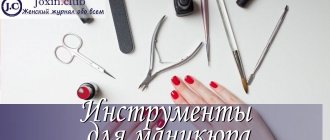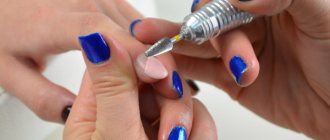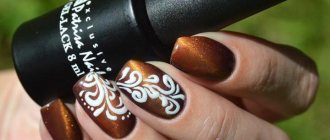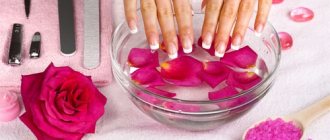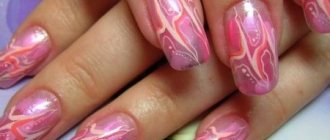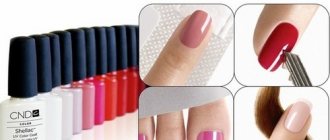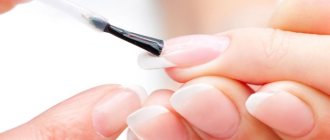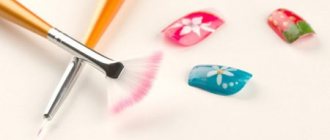Hardware manicure won our hearts quickly and for a long time. Of course, this particular type of processing of our fingers is considered the safest, “cleanest” and neatest. It’s also not that difficult to learn how to operate the device on your own. Have you ever wondered how much time and money it takes to go to beauty salons? We are confident that anyone with a little preparation will be able to perform a hardware manicure procedure at home on their own. We hasten to tell you how to do this!
What is hardware manicure
Hardware manicure is one of the methods of nail care that is rapidly gaining popularity, and more and more women prefer it. It was invented not so long ago in Germany by beauty salon masters. It is based on a method of caring for nail plates without the use of cutting tools (or with partial use).
Principle of operation
The essence of this method is to remove the cuticle with a milling cutter. Afterwards, using various types of attachments, the nail plate is thoroughly polished, and the skin along the contour of the nail is removed. Hardware manicure is classified as a class of gentle nail procedures, which are recommended to be done no more than once every 2 weeks.
It is strictly forbidden to use the device on wet skin, since the cutter operating at high speed will begin to tear the skin steamed in hot water instead of cleaning it.
A technician with little experience may not be able to control the pressure and, pressing the attachment too hard, will scratch the nail and leave grooves on the surface. The same problem applies to beginners who decide to purchase a similar device for home nail treatment. In both cases, you should be extremely careful and calmly gain experience.
Hardware manicure is a good choice if the cuticle grows too quickly or the nail plate becomes layered with unevenness and ribbing.
It is also recommended to perform it on extended nails for gentle care.
The impact of such a procedure is hardly noticeable on neglected nails and is not at all related to the quality of the attachments. In such cases, manicurists use combined solutions, first treating the nail plates with a machine, and then completing the process with cutting devices.
Requirements for the treated surface
For owners or future owners of the device, you need to know what the surface of the nail should be during treatment.
The hardware procedure should be carried out exclusively on dry nails. Even very well wiped nails should no longer be treated with a tool after washing your hands, as they absorb moisture very quickly. When working due to moisture, such nails will begin to heat up, which will cause, at best, unpleasant sensations or lead to damage to the nail.
If the device has a system for manually adjusting the number of revolutions, a beginner should not set the speed too high or too low. In the first case, you can accidentally damage the nail, in the second, it can lead to heating of the plate, even if it is perfectly dry. An acceptable option would be no more than 10,000 rpm.
Benefits of hardware manicure
Once you pay a large sum and purchase the device, you can forget about expensive hand care products and tools forever. Working with nails becomes safe, eliminates the risk of injury, makes the procedure painless and allows you to simultaneously work with both the cuticle and the nail. Also, with timely sterilization of attachments, the chance of infection after treatment disappears.
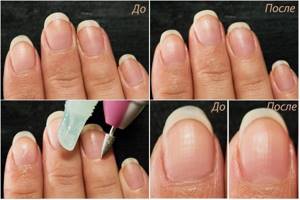
Hardware manicure (training for beginners helps to learn the basics of safe nail adjustments) provides the opportunity to process even very fragile and thin nail plates without risk and takes less time than working with hand tools, helping to quickly change the length and shape of the nail.
All these advantages, despite the presence of a list of some contraindications, allow you to treat problem nails with this method.
Disadvantages of hardware manicure
The hardware method has its drawbacks, such as mandatory training, even if a beginner is going to carry out the procedures at home. After all, for efficient and trouble-free work, you need to choose the right nozzle and its speed for processing each individual area.
The lack of professionalism of the master can turn an initially useful procedure into a painful horror, especially when it comes to treating nails for a person with a thin nail plate. It is best for such people to contact professionals with extensive experience in this field.
Advantages and disadvantages
Naturally, each cosmetic procedure has its own advantages and disadvantages. Among the advantages it should be noted:
- Session speed. No need to waste time soaking cuticles, removing skin with incisors, etc.;
- There is absolutely no chance of being cut or stabbed. Machine attachments completely eliminate this possibility. In addition, they help ensure long-lasting results;
- A trimmed manicure causes the cuticle to grow in an unnatural direction, while a hardware manicure simply corrects its appearance. This is very important for those who visit beauty salons no more than once a month;
- It is not so dangerous in terms of introducing infections or fungi under the skin.
But hardware manicure technology is not as good as it seems. Firstly, a lot depends on the master, his experience and attentiveness. For a correct and high-quality result, you need to change attachments several times and carefully inspect the treated areas.

Photo – Machine for hardware manicure
Secondly, consistency is extremely important. You cannot first polish the nail and then clean off the cuticle - this can negatively affect its structure or even damage the epidermis. And the most important point is that the tool must either be processed regularly or used as a disposable one. When processing cutters after each use, they are destroyed faster, and this entails additional costs.
When choosing which manicure is better, hardware or edged, you need to compare all the pros and cons. Of course, trimming with scissors looks more effective and has a greater effect. But on the other hand, the hardware version of the service guarantees protection against wounds and cuts, blood infections and many other factors.
Contraindications to the procedure
It is not permissible to perform a hardware manicure on the nails of a woman suffering from one of the following ailments:
- The cuticles are inflamed and swollen;
- The skin next to the nail has damage (scratches, wounds);
- The nail is affected by a fungal infection;

- The cuticle is too thin;
- Microvessels are located too close to the cuticle;
- Severely deformed nail plates also cannot be treated with the device.
Don't miss the most popular article in the section: How to draw monograms on nails step by step for beginners. Instructions with photos.
Safety rules when working with a manicure device
- Before starting work, be sure to inspect the device; if damage is found, do not turn it on;
- Never operate the device with wet hands;
- Be sure to fix your elbow on the table to prevent movements that could lead to injury;
- Move in the same direction as the cutter (it can rotate left or right). Otherwise, the cutter may slip off the surface of the nail plate;
- Don't turn the cutter too much when trying to work on awkward spots. Better turn your finger;
- Insert the nozzle all the way and only when the device is turned off;
- Do not turn on the device without the nozzle;
- Store the device with the rod inserted;
- Felt an unusual vibration? Turn off the device and contact a repair technician.
Preparing for a manicure
Hardware manicure starts in another 30 minutes. before starting to work on your nails. The client's hands should be washed well with soap and then allowed time to dry completely.
During the training period, beginners need to learn that before starting the procedure, all elements involved in it must be disinfected. This applies to manicure tools, hardware attachments, skin and nails on the hands of the client and the master. Antiseptic solutions or regular medical alcohol are good for this.
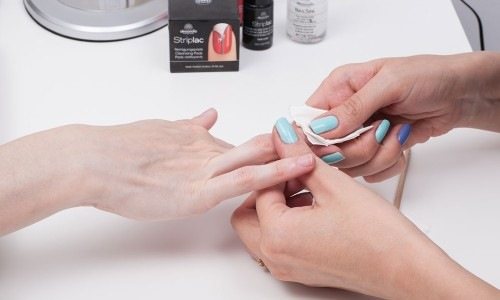
After this, the nails are degreased. If there is old varnish, it is removed with a special solution (preferably not containing acetone compounds). A softening agent is applied to the cuticle of the nail, after which it remains to wait for its effect.
Types of milling cutters and attachments
In general, manicure cutters can be divided into three categories based on performance:
- home - devices support about 2000 rpm, power does not exceed 30 W;
- universal for extensions - productivity is up to 60 W, the device develops up to 35,000 revolutions per minute and is used when processing acrylic and gel plates;
- professional - salon-type devices support up to 45,000 revolutions with a power of more than 60 W.
The first two types of devices are well suited for independent use. At a moderate cost, they provide high-quality nail treatment.
There are a wide variety of attachments for manicure devices, or cutters. According to the material they are:
- with ceramic coating and carbide, for processing cuticles;
- corundum and diamond, for removing the hardest artificial coatings;
- sand - for cutting off rough skin.
Basically, when performing manicures, the following forms of attachments are used:
- “flame” is the most popular cutter for processing cuticles and pterygium;
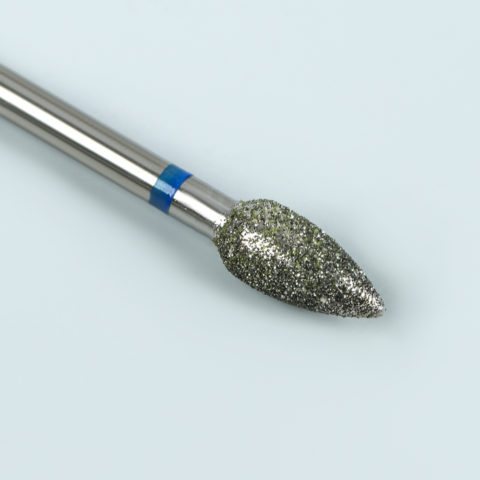
The flame attachment should be in contact with the nail at an angle of 45° - “corn” - a manicure cutter with notches is used to cut the artificial nail to length and reduce its thickness;
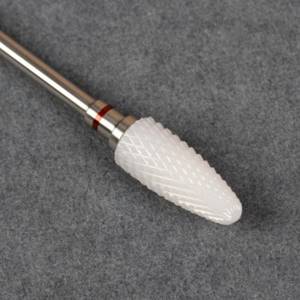
"Corn" requires operation at a speed of about 20,000 rpm - “cone” - using a nozzle, they lift and open the cuticle;
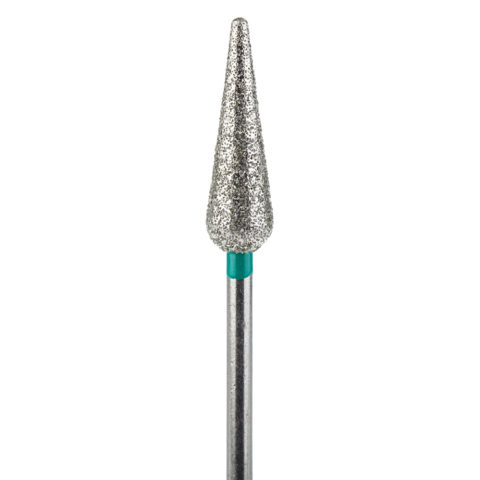
You need to hold the “cone” nozzle perpendicular to the surface - “ball” - the nozzle helps remove the treated skin at the base of the nail.

The smallest spherical cutters can be used to cut off the pterygium - a thin extension of the cuticle
For a home manicure router, you need to purchase the maximum number of attachments so that the tool is truly universal.
Hardware cuticle processing technique: step-by-step instructions for beginners
When performing a hardware procedure, you should first adhere to the following list of rules:
- After the softening agent has taken effect, you should immediately begin treating the skin and cuticle. A diamond bit is best for this. The main thing is to listen to the client if he feels discomfort, pain or heating of the nail.

- Once the skin treatment is completed, you should switch to maintaining the nail itself to give it the desired shape. To do this, the nozzle changes to trapezoidal or cylindrical. It is important to ensure that the length of the remaining nail is not less than 2mm.
- The most difficult stage for beginners in hardware manicure is polishing. The edge of the polishing attachment does not come close to the nail plate. The difficulty of performing this work is compensated by its speed, since its important part is the rule - the device does not linger at each point for more than one second.

Polishing the edge of the nail is the most difficult stage in hardware manicure for beginners. - The final stage of the entire procedure is the application of nourishing oils to obtain ideal care. Apart from its cosmetic and medicinal purposes, the nourishing oil also helps get rid of skin and nail particles.
Safety precautions: what to pay attention to
These tips will help you avoid unexpected injuries:
- during operation, the router is held at an angle of 45⁰;
- the attachments always move along the nail - if you keep them in one area for a long time, a cut or abrasion will appear;
- no sudden movements;
- When doing manicure, do not set the speed to more than 15 thousand rpm;
- for thin and brittle nails, use ceramic cutters with fine abrasive particles; for hard ribbed plates and rough skin, use coarse abrasive diamond tips.
It is also advisable to take breaks in the operation of the device every 20 minutes (if your hands are tired and long-term treatment is needed) - this will prevent the device from overheating.
Cutters for hardware manicure: types
The hardware type of manicure is replete with a variety of cutters, which are not limited only to the difference in abrasiveness. Quite important parameters are the limitation of operating revolutions per minute and differences in tip diameter.
Depending on their purpose, all nozzles are divided into three large groups:
- Attachments for working with the shape of the nail plate and for filing it.
- Attachments for grinding the surface of the nail and cutting it.
- Attachments for final polishing work to make the surface shiny.
Also, these groups have their own divisions of attachments with other features.
What cutters are needed for hardware manicure:
Ceramic tips
Hardware manicure (training for beginners involves starting practice with a ceramic type of attachment) involves removing the old coating, for which the most common attachment among nail service salon workers is ideal. It is called “corn” because it has a characteristic appearance.
Its purpose is high-quality and painless removal of gel polish (there is a version of the attachment for left-handers).
Also on the list of popular attachments is the “carrot”, which has received recognition for the quality of nail polishing.
The main purpose of ceramic attachments is to treat the nail and the skin around it.
Such attachments have an inherent hardness indicator, which is marked with special colors on the rim under the main working surface.
Correspondence of color to cutter rigidity indicator:
- Pink or blue color – fine-grained cutter.
- White – a cutter with a medium grain size.
- Black – coarse grain.
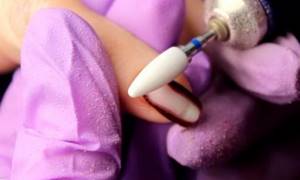
The first type from the list is well suited for soft treatment of the skin along the contour of the nail plate. The second one will serve for removing pterygium and gently removing gel polish. The latter is designed to remove keratinized areas of the skin or calluses. Such attachments should be stored carefully so that they are not subject to harmful mechanical influences.
Diamond bits
Diamond bits are an important tool, divided into many types according to the shape of the product and its abrasiveness. Typically they consist of a steel rod coated with a diamond coating (natural or artificial).
Just as in the case of ceramic cutters, abrasiveness can be determined by the color of the rim:
- Yellow color is the smallest crumb, no more than 15 microns.
- Red color – small crumbs, from 30 to 50 microns.
- Blue – medium crumb, from 90 to 125 microns.
- Green – slightly coarser than average, from 125 to 181 microns.
- Black – large grains, within 300 microns.
- Two black marks are very large grains, around 500 µm.
Rare are diamond attachments with white or three black marks, the so-called grinder cutters, which simultaneously serve as a polishing tool. Scarce. Designed to remove heavily keratinized skin areas and thick layers of gel.
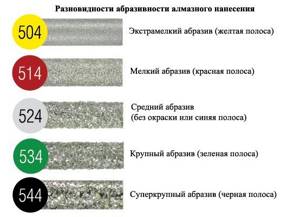
The successful outcome when cutting off gel polish depends on abrasiveness. Diamond cutters with green or red notches, made in Germany, are in great demand. It is believed that they are of the highest quality in execution. But there is an analogue made in Russia.
Metal nozzles
Metal cutters, unlike diamond ones, have a lower price, although they are used for the same purposes. Usually made from alloys of carbide and tungsten - medical steel. Among the features of steel cutters, one can note the patterns (notches) on the working surface. They can be straight, oblique or spiral.

Such attachments are well suited for removing dead skin, and not with dust, as usual, but with shavings. It is noteworthy that among the models of steel cutters there is a version made in a “corn” shape, which is used for removing old gel polish.
Silicone tips
Silicone nozzles belong to the group of polishing nozzles suitable for both artificial and natural nails. Adding shine to the nail plate can be achieved precisely by using these attachments.
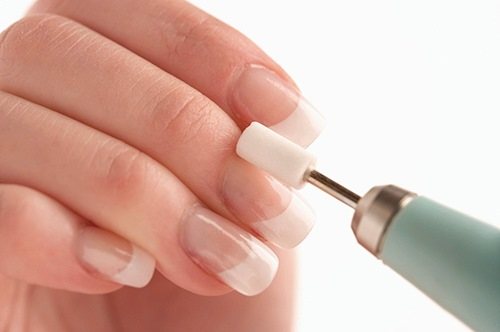
They have divisions according to abrasiveness, which is determined by touch: from almost smooth to rough options for grinding. They are made of silicone interspersed with abrasive particles.
List of stages

Professional training in hardware manicure involves a systematic approach that can be outlined in technology and passed on to students for practical use. The classic scheme, accepted by most masters, comes down to the following steps:
- Removing old coating;
- Shape sawdust;
- Creation and opening of a pocket under the cuticle;
- Raising the “skirt”;
- Cleaning the pterygium and lateral sinuses;
- Cuticle cut.
We will analyze each stage separately with the intricacies of working in a specific area of the nail.
What is hardware manicure, features of its implementation
Toolbox processing
Tools and attachments should be cleaned after each use. The cutters are washed with water, and at the same time, particles of skin are removed from them using a brass brush.
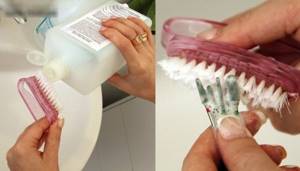
Cleaning in an ultrasonic sterilizer is also a good option. It works on the principle of purification by vibration, which causes the liquid to vibrate. Microbubbles formed as a result of such exposure explode, clearing dirt from hard-to-reach places on the instrument.
Instruments are treated with antiseptic solutions or sterilized in special cabinets, for example, in a dry heater.

All instruments made of solid materials are placed in it, after which they are heat treated in an environment with a temperature of 180 ᵒC for 30 minutes, then removed and placed in sterile containers with a sealed lid.
What is gel polish and how does it work?
First, let's figure out what gel polish is? This durable polymer nail coating is a well-known and popular manicure option today.
Pros of gel polish
Gel polish coating has several advantages , which is why it is much more popular than regular polishes.
- Gel polish is durable - lasts from two weeks to a month and pleases the owner with its appearance.
- The strength of gel polish allows the manicure to retain its color, does not rub off from the nails or get scratched, does not allow the nails to break, and they grow faster.
- A wide range of gel polishes allows you to choose a coating that will not spoil your nails and, on the contrary, will strengthen them.
- The choice of color palette and designs is huge. You can create different colors, patterns and combinations of patterns - it will be useful for all lovers of “something new”.
Criteria for choosing devices for manicure
Hardware manicure (training for novice specialists sometimes takes place on a self-purchased device) is closely related to understanding the criteria for choosing a device.
The first one is power. For personal use, you don’t need a very powerful milling cutter, so you should pay attention to models with a stated power of at least 35, but not more than 50 W. However, if the specialists are visited by at least 5 clients every day, then you should pay attention to models with a power of 100 watts or more to reduce the procedure time.
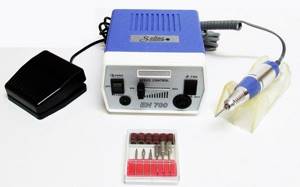
The second is the number of revolutions. Models with up to 20,000 rpm. suitable for home use. If the number of clients is more than 5 people per day, you should choose a device operating at 35,000 rpm. and more. In cases of professional manicure, the machine must have a speed of 45,000 rpm.
The next criterion will be the provided cutters included in the package. It is very good if the device is equipped with a starting list of basic attachments.
In the best case, you need to include among them:
- For treating rollers and cuticles.
- Nozzles for grinding work.
- Nozzles for polishing the nail plate.
- Attachments for working with keratinized skin.
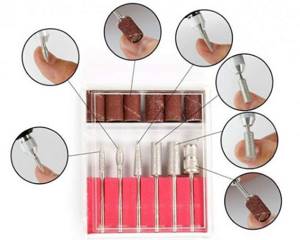
The devices also differ in the method of clamping the nozzle. There are 3 types in total:
- manual;
- semi-automatic;
- auto.
Inexpensive models for home use use a manual clamp that secures the working part of the tool when tightening the washer. A more expensive device will be equipped with a semi-automatic method of fixing the nozzle when the lever is tightened. And the most expensive devices come with an automatic clamping system that locks the nozzle immediately after its installation.
Working tools for performing hardware manicure are equipped with a brushed or brushless motor. The difference is that a brushed motor is designed to last for several hundred hours, while a brushless motor lasts for several thousand.
A machine with a brushless motor will cost more, but it is quieter than its counterpart with a brushed motor, and is distinguished by the quality and durability of its design. Devices with a commutator motor, despite their shortcomings, can handle a home manicure quite well.
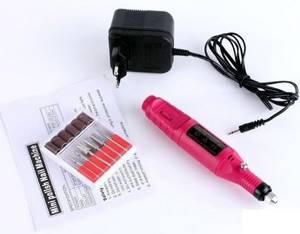
The last selection criterion is related to the fine dust released during operation of the machine. To reduce its amount, you can choose a model of the device with a vacuum cleaner built into the countertop, equipped with a retractable tray for quickly cleaning the filter from accumulated sawdust. If a vacuum cleaner is not provided at all, you can purchase it separately complete with a stand, dust collector and filter.
Rating of the best professional manicure cutters
Professional milling cutters are usually purchased by home manicurists. The devices are quite expensive, but offer improved capabilities.
Marathon 3 Champion SH20N
This Korean multifunctional manicure cutter is suitable for processing fingernails and toenails. Consists of a control unit, handle and holder, and includes a pedal. A reverse is provided for rotating the cutters in both directions, the maximum speed is 30,000 revolutions.
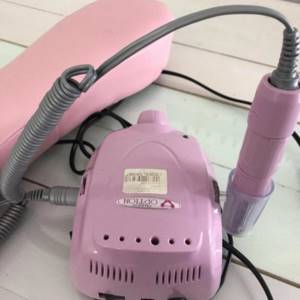
The price of the Marathon 3 manicure router starts from 9,000 rubles Pros
- good equipment;
- presence of a foot pedal;
- high speed of revolutions;
- there is a reverse.
Minuses
- few cutters included;
- high cost.
Strong 90N 102
One of the best nail cutters is equipped with a reverse mode. The set includes a foot pedal, usual for professional models, a stand and a spare fuse. Reviews of the manicure cutter note that you can change attachments in a matter of seconds. The speed of the device is a maximum of 34,000 revolutions, and the power is 64 W.
Important! The tip of the nail cutter is equipped with an air intake that prevents the engine from overheating.
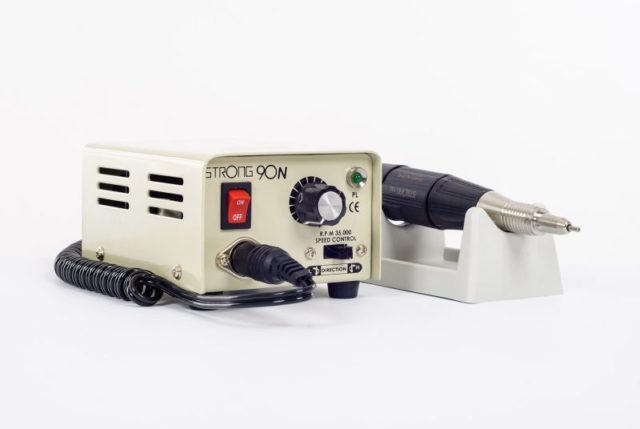
You can buy Strong 90N from 17,000 rubles
pros
- high power;
- foot pedal included;
- engine cooling function;
- overload shutdown.
Minuses
- very high price;
- no additional cutters included.
Nail Master ZS-603
A professional-type Chinese manicure apparatus consists of a control unit and a handle with attachments. Maintains operating speed from 5000 to 35000 rpm, power is 45 W. Made of durable heat-resistant plastic, available in several color variations. Supplied with a set of six cutters and a foot pedal.
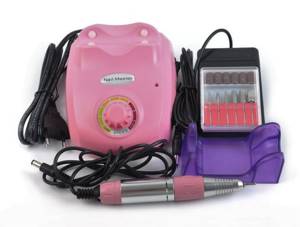
You can buy Nail Master ZS-603 from 3,500 rubles
pros
- good power and speed;
- additional cutters included;
- presence of a cooling system on the handle;
- operation from a network of 110 or 220 V.
Minuses
- low quality of complete cutters;
- strong heating during operation;
- Average build quality of the handle.
Review of popular devices for home use
Hardware manicure (training for beginners is also accompanied by the choice of the first device) cannot be done efficiently without a convenient tool. When choosing, they take into account in which room it will be produced and how the device will be used.
There is no need to spend money on expensive equipment if you have to do a manicure on yourself at home.
| Name _ | Production | Description | Advantages | Flaws | Average cost in Russia |
| RUNAIL PM-25000 | Russia (Assembled in China) | Inexpensive model ideal for home use. |
|
| 4500 rub. |
| TNL MP-68 | South Korea | Rich functionality for little money. Set includes 4 cutters. |
|
| 4300 rub. |
| IRISK JD-400 | USA (Assembled in China) | Bidirectional rotation mechanism with good power for modest money. |
|
| 5500 rub. |
| SCARLET MS95006 | China | A completely budget option for the simplest nail work. |
| Unsuitable for serious manipulations with the nail plate. | 700 rub. |
| VITEK VT-2201 VT | China | Cheap set for home nail care. |
|
| 2000 rub. |
| STRONG 90N 102 | South Korea | A good quality device in the mid-price segment, suitable for all types of manicure work. |
| The kit does not include attachments. | 17,000 rub. |
Don't miss the most popular article in the section: How to extend nails with gel polish. Nail extension instructions for beginners. Photo.
How to properly use a router with manicure attachments
The instructions for using a manicure cutter are quite simple:
- First of all, the fingers and plates are thoroughly treated with a disinfectant solution and wait for it to dry. Before doing a manicure with a router step by step, use a ceramic cone attachment to clean the nail from the old coating and give it the desired shape.
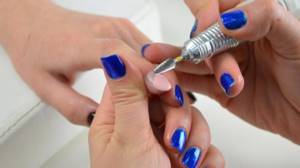
When using gel polish, you do not need to remove the base if it adheres well - Using a thin manicure cutter with a rounded tip at a speed of about 15,000 revolutions, lift the cuticle on all fingers and push it back. The nozzle is held parallel to the nail so as not to make a cut. When moving the cutter to the right, you need to move your hand to the left, and vice versa. At the same time, the side ridges of the skin near the nail are polished.
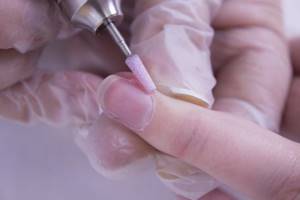
First, treat one half of the nails on all fingers, and then the second in reverse mode. - The attachment on the manicure cutter is replaced with a drill and the cuticle is thinned. The tip is guided only along the skin in one direction.
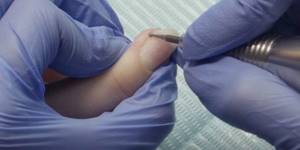
Do not touch the nail itself with the bur ball when treating the cuticle. - Change the nozzle to a small ball and cut off the cuticle. Videos about manicure with a router for beginners show that you need to move parallel to the nail, repeating its hole.

When cutting the cuticle, hold the cutter in one place for a maximum of five seconds - The attachment on the manicure cutter is changed to a polishing one and the nail is polished at a speed of about 7000 rpm. In the cuticle area, touch it with the very tip so as not to damage the tissue.
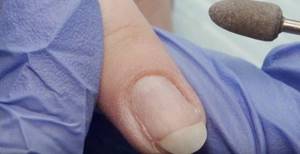
During the polishing process, the milling cutter should not be pressed against the nail; movements should be light
Finally, all that remains is to clean your fingers from nail dust with a brush. If you need to do a manicure, then apply varnish to the prepared plates; if coloring is not planned, rub softening and restoring oil into the cuticle.
What videos with master classes will help even a beginner get the perfect manicure?
To learn how to do a hardware manicure correctly, you should start with simple lessons that can be learned from video content with training for beginners. For example, Nadezhda Primak provides comprehensive information about hardware manicure on her official channel or during broadcasts on Periscope.
Olga Zyablova and Tatyana Shestakova show how to properly apply varnish and use artistic techniques in manicure. On the Kasya Nail Club channel, the presenter, Evgenia Isay, shows in close-up and talks in detail about working with a manicure machine, and about adjusting the result with cutting tools.
Author of the article: Fierce Oga
Article design: Svetlana Ovsyanikova
Material

Based on material, hardware cutters are divided into the following types:
- Carbide (metal)
- Ceramic
- Diamond
- Corundum
- Sand or silicon carbide copings
- Grinding - made of rubber, silicone, suede
Carbide

Made of metal and have notches on the surface. As they rotate, the notches cut away the skin or material, leaving a smooth surface.
They work on the principle of a knife. The more pronounced the notches, the deeper the metal penetrates into the extended material or skin.
Ceramic
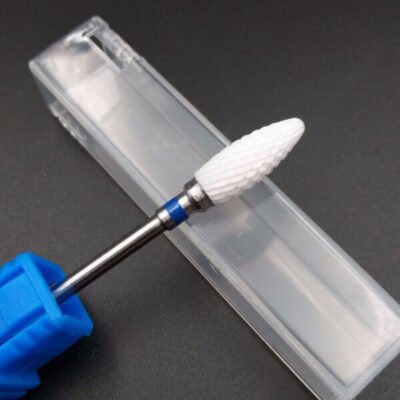
Made of ceramic, they also have notches on the surface. They are fragile, cracks and chips form when impacted, so they require more careful handling when working.
Diamond

They consist of a base and a coating of varying hardness or abrasiveness. Ceramic and diamond nozzles are the most popular in terms of the combination of price-quality-efficiency.
Corundum

They are characterized by high resistance to high temperatures and heating during operation.
Silicon carbide or sand copings
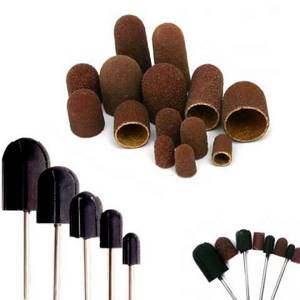
Used for pedicures to treat rough skin and corns. They have a cardboard base with spraying. Disposable. The caps are placed on a rubber base, which is sterilized after use, and the nozzles themselves are disposed of.
Grinding
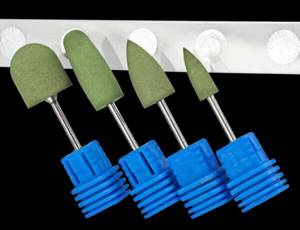
Depending on the base material - rubber, silicone or fabric, they make it possible to polish areas of different sensitivity in manicure and pedicure. They can also be used in tandem with oil or polishing cream if additional skin nutrition is needed. This is often true when treating feet in a pedicure.
